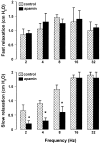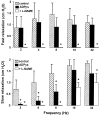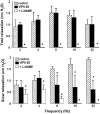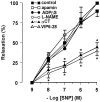NANC inhibitory neurotransmission in mouse isolated stomach: involvement of nitric oxide, ATP and vasoactive intestinal polypeptide
- PMID: 12970100
- PMCID: PMC1574027
- DOI: 10.1038/sj.bjp.0705431
NANC inhibitory neurotransmission in mouse isolated stomach: involvement of nitric oxide, ATP and vasoactive intestinal polypeptide
Abstract
1. The neurotransmitters involved in NANC relaxation and their possible interactions were investigated in mouse isolated stomach, recording the motor responses as changes of endoluminal pressure from whole organ. 2. Field stimulation produced tetrodotoxin-sensitive, frequency-dependent, biphasic responses: rapid transient relaxation followed by a delayed inhibitory component. 3. The inhibitor of the synthesis of nitric oxide (NO), l-NAME, abolished the rapid relaxation and significantly reduced the slow relaxation. Apamin, blocker of Ca2+-dependent K+ channels, or ADPbetaS, which desensitises P2y purinoceptors, reduced the slow relaxation to 2-8 Hz, without affecting that to 16-32 Hz or the fast relaxation. alpha-Chymotrypsin or vasoactive intestinal polypeptide 6-28 (VIP6-28), antagonist of VIP receptors, failed to affect the fast component or the delayed relaxation to 2-4 Hz, but antagonised the slow component to 8-32 Hz. 4. Relaxation to sodium nitroprusside was not affected by l-NAME, apamin or ADPbetaS, but was reduced by alpha-chymotrypsin or VIP6-28. Relaxation to VIP was abolished by alpha-chymotrypsin, antagonised by VIP6-28, but was not affected by l-NAME, apamin or ADPbetaS. Relaxation to ATP was abolished by apamin, antagonised by ADPbetaS, but was not affected by l-NAME or alpha-chymotrypsin. 5. The present results suggest that NO is responsible for the rapid relaxation and partly for the slow relaxation. ATP is involved in the slow relaxation evoked by low frequencies of stimulation. VIP is responsible for the slow relaxation evoked by high frequencies of stimulation. The different neurotransmitters appear to work in parallel, although NO could serve also as a neuromodulator that facilitates release of VIP.
Figures








Similar articles
-
Functional evidence that ATP or a related purine is an inhibitory NANC neurotransmitter in the mouse jejunum: study on the identity of P2X and P2Y purinoceptors involved.Br J Pharmacol. 2003 Nov;140(6):1108-16. doi: 10.1038/sj.bjp.0705536. Epub 2003 Oct 6. Br J Pharmacol. 2003. PMID: 14530212 Free PMC article.
-
Pharmacologic characterization of intrinsic mechanisms controlling tone and relaxation of porcine lower esophageal sphincter.J Pharmacol Exp Ther. 2006 Mar;316(3):1238-48. doi: 10.1124/jpet.105.094482. Epub 2005 Nov 22. J Pharmacol Exp Ther. 2006. PMID: 16303917
-
Involvement of nitric oxide and vasoactive intestinal peptide in the nonadrenergic-noncholinergic relaxation of the porcine retractor penis muscle.Jpn J Pharmacol. 2001 Jun;86(2):236-43. doi: 10.1254/jjp.86.236. Jpn J Pharmacol. 2001. PMID: 11459127
-
Characterization of the apamin- and L-nitroarginine-resistant NANC inhibitory transmission to the circular muscle of guinea-pig colon.J Auton Pharmacol. 1996 Jun;16(3):131-45. J Auton Pharmacol. 1996. PMID: 8884460
-
[The control of smooth muscle tissues by nonadrenergic noncholinergic (NANC) nerve fibres in the autonomic nervous system].J Smooth Muscle Res. 1995 Jun;31(3):67-78. doi: 10.1540/jsmr.31.67. J Smooth Muscle Res. 1995. PMID: 8563058 Review. Japanese.
Cited by
-
Comparison of inhibitory neuromuscular transmission in the Cynomolgus monkey IAS and rectum: special emphasis on differences in purinergic transmission.J Physiol. 2018 Nov;596(22):5319-5341. doi: 10.1113/JP275437. Epub 2018 Oct 13. J Physiol. 2018. PMID: 30198065 Free PMC article.
-
Roles of PACAP and PHI as inhibitory neurotransmitters in the circular muscle of mouse antrum.Pflugers Arch. 2006 Jan;451(4):559-68. doi: 10.1007/s00424-005-1491-6. Epub 2005 Nov 15. Pflugers Arch. 2006. PMID: 16292577
-
Evidence that resistin acts on the mechanical responses of the mouse gastric fundus.Front Physiol. 2022 Jul 15;13:930197. doi: 10.3389/fphys.2022.930197. eCollection 2022. Front Physiol. 2022. PMID: 35910552 Free PMC article.
-
Inhibitory responses to exogenous adenosine in murine proximal and distal colon.Br J Pharmacol. 2006 Aug;148(7):956-63. doi: 10.1038/sj.bjp.0706808. Epub 2006 Jul 3. Br J Pharmacol. 2006. PMID: 16847444 Free PMC article.
-
Myosin Va plays a role in nitrergic smooth muscle relaxation in gastric fundus and corpora cavernosa of penis.PLoS One. 2014 Feb 6;9(2):e86778. doi: 10.1371/journal.pone.0086778. eCollection 2014. PLoS One. 2014. PMID: 24516539 Free PMC article.
References
-
- ABRAHAMSSON H. Studies on the inhibitory nervous control of gastric motility. Acta Physiol. Scand. 1973;390:1–38. - PubMed
-
- ALLESCHER H.D., KURJAK M., HUBER A., TRUDRUNG P., SCHUSDZIARRA V. Regulation of VIP release from rat enteric nerve terminals: evidence for a stimulatory effect of NO. Am. J. Physiol. 1996;271:G568–G574. - PubMed
-
- BACCARI M.C., ROMAGNANI P., CALAMAI F. Impaired nitrergic relaxations in the gastric fundus of dystrophic (mdx) mice. Neurosci. Lett. 2000;282:105–108. - PubMed
-
- BARBIER A.J., LEFEBVRE R.A. Involvement of the L-arginine: nitric oxide pathway in nonadrenergic noncholinergic relaxation of the cat gastric fundus. J. Pharmacol. Exp. Ther. 1993;266:172–178. - PubMed
Publication types
MeSH terms
Substances
Grants and funding
LinkOut - more resources
Full Text Sources
Miscellaneous

